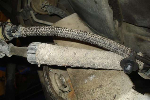I installed a Banshee M90 supercharger kit on my 2000 Explorer Sport with the 4.0L SOHC V6 engine.

The intake air temperature (IAT) climbed to 174 degrees during my last set of of pulls on the dyno.

As the IAT increases the PCM reduces spark advance to avoid detonation. Max power is reduced when the spark advance is less than optimum. The IAT is OK during normal driving and is excessive only during boost. There is an intercooler in the intake manifold between the output of the M90 blower and the head intake ports.

I installed a stock external ATF cooler on the driver side to act as a heat exchanger for the intercooler. Some airflow is blocked by hoses associated with my remote full flow and bypass oil filters, the passenger side external ATF cooler, and the thermostatically controlled engine oil cooler. Also, the lower part of the grille support blocks the lower two rows of the stacked plate cooler.

At first I thought the high IAT was due to the vehicle being stationary during dyno testing but during a short street pull a high IAT (164 deg F.) was also datalogged on a warm day driving at 50 mph.

There is about 1.5 inches between the back of the cooler and the front of the A/C condenser.

There is also room in front of the cooler if some of the hoses are relocated. I'm thinking about moving the cooler up and forward enough to place a puller fan between the cooler and the A/C condenser to increase airflow thru the cooler. My goal is to reduce the maximum IAT to about 150 degrees.
The intake air temperature (IAT) climbed to 174 degrees during my last set of of pulls on the dyno.
As the IAT increases the PCM reduces spark advance to avoid detonation. Max power is reduced when the spark advance is less than optimum. The IAT is OK during normal driving and is excessive only during boost. There is an intercooler in the intake manifold between the output of the M90 blower and the head intake ports.
I installed a stock external ATF cooler on the driver side to act as a heat exchanger for the intercooler. Some airflow is blocked by hoses associated with my remote full flow and bypass oil filters, the passenger side external ATF cooler, and the thermostatically controlled engine oil cooler. Also, the lower part of the grille support blocks the lower two rows of the stacked plate cooler.
At first I thought the high IAT was due to the vehicle being stationary during dyno testing but during a short street pull a high IAT (164 deg F.) was also datalogged on a warm day driving at 50 mph.
There is about 1.5 inches between the back of the cooler and the front of the A/C condenser.
There is also room in front of the cooler if some of the hoses are relocated. I'm thinking about moving the cooler up and forward enough to place a puller fan between the cooler and the A/C condenser to increase airflow thru the cooler. My goal is to reduce the maximum IAT to about 150 degrees.










